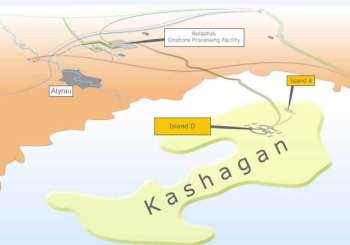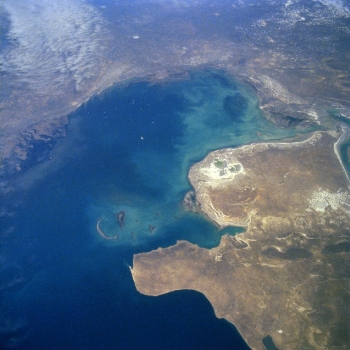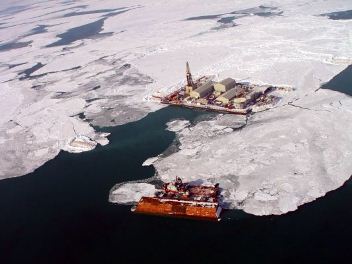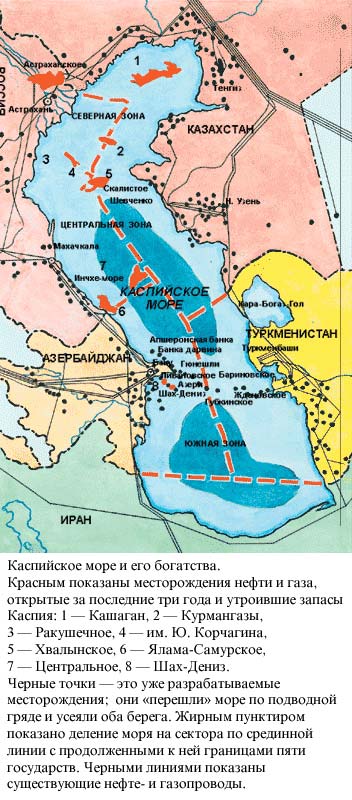 Since the end of last year there have been some significant events that attracted Kazakh media attention to the subject of Caspian oil. It is a question of two artificial islands’ ice blockade of the Kashagan oil field in December 2012, withdrawal of two investors from the Caspian shelf, two earthquakes in the Caspian Sea occurred on March 10, the recent accident at one of the drilling rigs at Kashagan and suppression of the truth about Caspian oil. Withdrawal of the American company from the Kashagan oil field with its projected giant hydrocarbon deposit on the eve of the start of commercial oil production (from June 2013) adds spice to the situation.
Since the end of last year there have been some significant events that attracted Kazakh media attention to the subject of Caspian oil. It is a question of two artificial islands’ ice blockade of the Kashagan oil field in December 2012, withdrawal of two investors from the Caspian shelf, two earthquakes in the Caspian Sea occurred on March 10, the recent accident at one of the drilling rigs at Kashagan and suppression of the truth about Caspian oil. Withdrawal of the American company from the Kashagan oil field with its projected giant hydrocarbon deposit on the eve of the start of commercial oil production (from June 2013) adds spice to the situation.
On this website this topic is covered in several articles: The Law of Natural Boomerang, Astana is facing a cataclysm, Interview with Galiya Kerey, Causes of oil spill in the Gulf of Mexico, Rain Purification of Kazakhstan and ect. There have been cited the forecasts of bio-energy specialist Galiya Kerey about the future of Caspian oil.
Why investors leave the Caspian Sea?
This problem has become topical once again since USA’s ConocoPhillips and Norway’s Statoil announced in February that they intend to sell their shares in Kazakh oil projects. In autumn 2012, ConocoPhillips posted on its website it had officially informed Kazakh authorities and partners of the intention to sell its share (8.4%) in the Kashagan project for 5 billion dollars. Then, in February, 2013, it was reported that the Norwegian Statoil company intends to withdraw from the project ‘Abai’ which is considered to be very promising. According to many observers, the Statoil’s withdrawal was the most painful in a series of Western oil companies’ withdrawals from the Caspian shelf of Kazakhstan. Moreover, in 2012 several major players refused to participate in projects in the Caspian shelf of Kazakhstan. There included: the French company ‘Total’ which officially refused to develop the ’Zhenis’ field; the Italian state company ’Eni’ refused to develop the ’Shagala’ field; the American company ConocoPhillips sold its stake in the ‘N’ project to the ‘KazMunaiGas’ company. In addition, there was not resumed the project of ‘South Zhumabai’ field.
 If you look for answers to this question directly related to the image of our country as a future oil giant in the Caspian Sea, you will find a number of standard conclusions. Allegedly, the main reason is the current system of state regulation. The Government of Kazakhstan imposes stringent requirements on oil companies in terms of local content and social investments; investors suffer artificially imposed huge environmental penalties. A separate problem is cost overrun and delay in the commissioning of the project because of technical difficulties. All these problems have been attributed to inefficient management and other obstacles that do not disclose the real reason of the investors’ escape.
If you look for answers to this question directly related to the image of our country as a future oil giant in the Caspian Sea, you will find a number of standard conclusions. Allegedly, the main reason is the current system of state regulation. The Government of Kazakhstan imposes stringent requirements on oil companies in terms of local content and social investments; investors suffer artificially imposed huge environmental penalties. A separate problem is cost overrun and delay in the commissioning of the project because of technical difficulties. All these problems have been attributed to inefficient management and other obstacles that do not disclose the real reason of the investors’ escape.
At the same time experts don’t want to accept and take into account the obvious fact: oil companies don’t leave onshore oil fields. So the above conclusions do not have a systematic approach. And if we put the Caspian card on the table and find missing puzzles then we will discover the root causes of foreign companies’ withdrawal in the literal sense of the word: there is ‘farewell kiss’ instead of giant oil field.
However, if you ask skilled oilmen, including Candidates of Science, who wrote their dissertations on the Caspian shelf, about probable absence of oil in the Caspian Sea, they will begin to laugh. They say oil was formed over millions of years: there either it is or it’s not, but it’s impossible that oil was there and then disappeared without its extraction within some ten years.
The confirmation of the Kashagan field hydrocarbon reserves was announced in summer 2000, based on the inspection results of the first well’s drilling KE-1 (Eastern Kashagan-1). Its daily production amounted to 600 m3 of oil and 200 thousand cubic meters of gas. In May, 2001 a second exploration well was drilled in 40 km from the first in the west area of Kashagan. It showed the daily production rate at 540 m3 of oil and 215 thousand m3 of gas. What kind of proof do you need? What doubts can be in big Caspian oil?!
All to the last man – investors, including those who have already withdrawn from the projects, oil and contracting companies, local authorities, the Government of Kazakhstan, suppliers, etc. – are unanimous in opinion on existence of large deposit of oil, even if some facts suggest otherwise. If ConocoPhillips expressed a doubt about existence of hydrocarbons, it couldn’t sell its share – the company has been unable to resolve this problem for several months.
We will expel drillers from the Caspian Sea at all costs
 The paradox of the Caspian phenomenon is that before official confirmation of giant hydrocarbon reserves at Kashagan, there was the newspaper article which has defined all subsequent events in oil industry we are witnessing.
The paradox of the Caspian phenomenon is that before official confirmation of giant hydrocarbon reserves at Kashagan, there was the newspaper article which has defined all subsequent events in oil industry we are witnessing.
On February 8, 2000 in the newspaper ‘SolDat’ there was published the article titled “What stars, Moon and Galiya talk about Caspian oil” based on the information of bio-energy specialist from Almaty Galiya Kerey. In the article it was said: “It is not necessary to spend time, money and efforts on oil exploration in the waters of the Caspian Sea. In order to discover oil, it is necessary to abandon senseless projects in the Caspian shelf (they will bring nothing, except new troubles) and, having accepted a series of democratic nature conservation laws, to carry out works in other direction.” Moreover, it was said about oil itself in the Caspian Sea: “It is quite certain that oil won’t be found in the offshore area of the North Caspian. It has been moved into the regions of Western Kazakhstan and stretches further east and across the South of the country. Moon and Jupiter may influence not only on the Earth’s tides, but also on any natural process. They just moved oil to the coastal area of the Caspian Sea, to the West of Kazakhstan, to the Ustyurt Plateau and further East across the southern regions of Kazakhstan, putting at the same time obstacles in the way of the Caspian shelf drilling (physical barriers, unfavorable weather conditions, criticism of the press and environmentalists, collision of geopolitical interests of the Caspian states and etc.) In those days (March, 1999) Supreme Powers gave Galiya this information (word for word): “We have created tons of rubbish on the way of drilling. We have removed oil towards land on the territory of Kazakhstan. Henceforth, oil won’t be found in the Caspian Sea”.
This forecast is repeated many times in other articles of this newspaper and in the “Book of the Moon” written by Toktasyn Nurgaliyev and Galiya Kerey (Almaty, 2004). “Countless oil reserves will be discovered not in the Caspian Sea, but in the South of Kazakhstan. Priaralye, Mangyshlak, the region of Aktyubinsk, the South of Kazakhstan will become oil-bearing areas. And there will stop producing oil in the Caspian offshore area” (“What stars, Moon and Galiya talk about”. “SolDat” № 58, December, 2001). But in “the Book of the Moon” was said about withdrawal of investors: “We will drive drillers from the Caspian Sea at all costs” (p. 305).
Over the past decade we have heard a lot about physical barriers, obstacles in the way of drilling, caprices of the weather conditions, etc.: for all these reasons and for others, the date of first oil production at Kashagan was postponed several times, from 2005 to 2008, then to 2011, and the last agreement – 2013. Besides, Kashagan is the most expensive (!) energy project in the history, its cost – 136 billion dollars.
 In mid-December last year due to weather conditions artificial islands Block A and Block D of the offshore Kashagan oil field in the North Caspian were caught in ice blockade. The food supply lines were interrupted. Construction rubbish and municipal wastes, taking usually away to the ports of Aktau for further utilization, greatly amassed at the islands. If this happened during oil production, a disaster would be unavoidable.
In mid-December last year due to weather conditions artificial islands Block A and Block D of the offshore Kashagan oil field in the North Caspian were caught in ice blockade. The food supply lines were interrupted. Construction rubbish and municipal wastes, taking usually away to the ports of Aktau for further utilization, greatly amassed at the islands. If this happened during oil production, a disaster would be unavoidable.
In early March this year there was not entirely clear information about the accident at one of the drilling rigs on artificial island D of the Kashagan oil field. According to the information given by the Emergency Situations Department “drilling gear bended at the rig and fittings broke down because of excessive load”. Most likely, it’s not a small accident and it’s lucky that oil production has not started yet.
If we analyze the Caspian Sea earthquakes database we discover that the earthquake activity in this area has increased over the last two-three years. On March 10, there were occurred in a small time interval two earthquakes measuring 4.2 and 3.9 on the Richter scale at the level of the Kara-Bogaz-Gol. What’s happening in the depths of the sea?
Law of natural boomerang
Of course, opponents can say that the future of the Kazakhstan Caspian shelf resources will depend on the first oil output at Kashagan – it won’t be long now. However, it is time to analyze also the situation in other coastal regions in order to fold the puzzle of Caspian oil.
And now let’s give the floor to Galiya Kerey, bio-energy specialist: “Recently, I watched at RBC TV-Channel a “round table” on Caspian oil where the Russian experts on facts told openly about the situation our experts prefer to be silent. In a few words: big oil in the Caspian Sea is myth, including Kashagan, Dagestan, Kalmykia, as evidenced by the significant decline in oil production in the Azerbaijan shelf of the Caspian Sea in recent years, decrease in oil production in Dagestan and etc. And we wrote about it back in 2000.
 We need to understand a very simple thing: oil cannot be extracted anywhere and anyhow, especially under the sea, in an enclosed body of water, because no one knows what threatening consequences it can lead to. For this reason, in the Soviet times the shelf development of the Northern Caspian was under a ban – environmental laws, protection of this zone as reserve interfered with it. In nature there are things that cannot be overstepped, otherwise there will be an environmental disaster. The Caspian Sea is a repeater, receiver/distributor of cosmic energy, an energy umbilical cord of our planet, through which the Earth receives necessary energy, and the state of nature on our planet depends on how the Caspian manages this function. Not without reason here is the homeland of sturgeon that was being caught in ancient times: in fact, 90% of the world resources of sturgeon originate from the Caspian Sea. On the other hand, oil in the Caspian Sea was created by Supreme Powers not for its production. Oil in the Caspian Sea is one of the components of this receiver-distributer of cosmic energy.
We need to understand a very simple thing: oil cannot be extracted anywhere and anyhow, especially under the sea, in an enclosed body of water, because no one knows what threatening consequences it can lead to. For this reason, in the Soviet times the shelf development of the Northern Caspian was under a ban – environmental laws, protection of this zone as reserve interfered with it. In nature there are things that cannot be overstepped, otherwise there will be an environmental disaster. The Caspian Sea is a repeater, receiver/distributor of cosmic energy, an energy umbilical cord of our planet, through which the Earth receives necessary energy, and the state of nature on our planet depends on how the Caspian manages this function. Not without reason here is the homeland of sturgeon that was being caught in ancient times: in fact, 90% of the world resources of sturgeon originate from the Caspian Sea. On the other hand, oil in the Caspian Sea was created by Supreme Powers not for its production. Oil in the Caspian Sea is one of the components of this receiver-distributer of cosmic energy.
Frequent earthquakes in the sea in the last years and two recent shocks – it is Nature response to human unreasonable actions in the sea, in such a way oil and gas ingress will be closed. To prevent a disaster such as the explosion of the oil rig in the Gulf of Mexico, now the Caspian Sea is being purified of oil, gas, old water. The Caspian Sea will be reborn. The oil that now is being produced on the shelf is remains, sediment of the former oil and over time there will be less and less oil up to complete disappearance. Not only nature has suffered but also the economy of Kazakhstan – the Agip’s adventurous project at Kashagan with its needlessness, high cost and corruption has led to a crisis in the country”.
In addition, since recently, there has been observed hardly hidden panic concerning unexpected decrease in offshore oil production in Azerbaijan and in this regard the foreign companies have faced strong criticism from the President Aliyev. According to him, the sharp reduction in oil output has begun since 2008: the international consortium produced only 40.3 million tons in 2009, 40.6 million tons in 2010, and 36 million tons in 2011. According to other sources, oil production in 2011 was decreased by 10.3% in comparison with 2010. In January-May it was 6.9% less than in the same period of 2011. On the other hand, from 1997 to 2007 the high growth rates in oil production were recorded (GDP as well): from 8.9 million to 41.7 million tons! By the way, the Norwegian Statoil, which left the Kazakhstan Abay project, works in the Azerbaijan part of the Caspian Sea, the company draws the corresponding conclusions.
Dastan ELDESOV
March 29, 2013

Nice answer back in return of this issue with solid arguments and describing the whole thing on the topic of that.